Till the early 20th century Asia was referred to as one entity – the Orient. Subdivision of its regions changed the nomenclatures to Near East, East (the Indian subcontinent) and the Far East. This continued till the Second World War, when South East Asia came into vogue – to refer to the region under Japanese subjugation and the South East Asia Command was raised by the Allies during the Second World War. Even after the demise of colonialism, the Indian subcontinent continued to be referred as such, till the breakup of the erstwhile Soviet Union, when the Central Asian Republics came into separate entities. Asia then became divided into different sub regions – West Asia, Central Asia, South Asia, East Asia (or the Pacific Rim), North East Asia and South East Asia. The Indian subcontinent and its neighbourhood now need to be seen from a regional geographic perspective in order to outline its strategic importance.
Indias geographic position along the sea lines connecting the Persian Gulf with Asias other growing economies reinforces Indias potential to be a security provider along this crucial route.
South Asia is the southern geopolitical region of the Asian continent comprising territories which geo-physically lie on the Indian Plate (bordered on the north by the Eurasian Plate) and are south of the Himalayas and the Hindu Kush mountain ranges. It is surrounded by (from west to east) Western Asia, Central Asia, Eastern Asia, and South East Asia. Geopolitically, South Asia also includes territories found external to the Indian Plate and in proximity to it. Afghanistan is sometimes grouped in this region due to socio-political ties to Pakistan, and because it was a part of the Indian Maurya and Mughal empires.
According to the United Nations, South Asia comprises nine nations – Iran, Afghanistan, Pakistan, India, Nepal, Bhutan, Bangladesh,
Sri Lanka and Maldives. South Asia is the place where West, Central, Southeast, and East Asia meet, and where the dominant cultures of these sub-regions have competed for influence over the centuries. In Samuel Huntington’s terms, the region lies across the fault lines between four major civilisations, those of the Muslims, Hindus, Buddhists, and Confucians.
The region has a long history. Ancient civilisations developed in the Dwarka region and the Indus River Valley. The region was at its most prosperous before the 18th century, when the Mughal Empire held sway. European colonialism led to its expansion in the region, by Portugal and Holland, and later Britain and to a lesser degree France. Most of the region gained independence from Europe by the late 1940s.
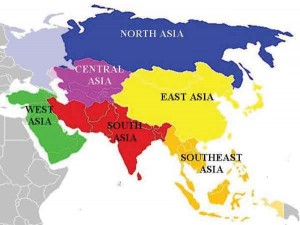 Southern Asia is also a socio-political sphere that has historically come under influence of the politics, culture, religion and languages of India. Mainland Southeast Asia was a recipient of Indian-influenced culture, literature, philosophy, political systems, architecture, music, and religion (Brahmanic Hinduism and Theravada Buddhism). This Indo-sphere includes Myanmar (“Burma”), Laos, Thailand, and Cambodia, although Indonesia and Malaysia too absorbed much Indian influence before the coming of Islam to Southeast Asia. Countries with significant current or historical Indian cultural influence are Afghanistan, Tibet Autonomous Region, Yunnan province of China and the Baluchistan region. The countries of South Asia are thus connected by historical and cultural ties, in language, faith, belief, customs, traditions and literature and have a common destiny. The region prospered through trade over many centuries. It is a signpost for future well-being also.Southern Asia is also a socio-political sphere that has historically come under influence of the politics, culture, religion and languages of India.
Southern Asia is also a socio-political sphere that has historically come under influence of the politics, culture, religion and languages of India. Mainland Southeast Asia was a recipient of Indian-influenced culture, literature, philosophy, political systems, architecture, music, and religion (Brahmanic Hinduism and Theravada Buddhism). This Indo-sphere includes Myanmar (“Burma”), Laos, Thailand, and Cambodia, although Indonesia and Malaysia too absorbed much Indian influence before the coming of Islam to Southeast Asia. Countries with significant current or historical Indian cultural influence are Afghanistan, Tibet Autonomous Region, Yunnan province of China and the Baluchistan region. The countries of South Asia are thus connected by historical and cultural ties, in language, faith, belief, customs, traditions and literature and have a common destiny. The region prospered through trade over many centuries. It is a signpost for future well-being also.Southern Asia is also a socio-political sphere that has historically come under influence of the politics, culture, religion and languages of India.Persian, Arab and Turkish cultural traditions also form an integral part of Islamic South Asian culture, but have been radically adapted to form a Muslim culture distinct from what is found in the Middle East e.g. the spread of Sufism and pilgrimage to dargahs. About 60% of people in South Asia follow Hinduism and 30% follow Islam. The peoples of the region possess several distinguishing features that set them apart anthropologically from the rest of Asia. The dominant peoples and cultures are Indo-Aryan and Dravidian, with some Mongoloid races, and have a greater affinity with Europe than with most other regions of Asia, excepting the Iranian Plateau and the Caucasus. South Asia comprises an area of 5,130,746 square kilometres and ranks among the world’s most densely-populated regions with about 1.6 billion people — about a quarter of all the people in the world. The region’s population density of 305 persons per square kilometre is more than seven times the world average.
South Asian countries have different forms of government; their democratic institutions are still developing, with a civil society that is still struggling to define its space. The importance of this region is two-fold due to its inter-state rivalries and its intra-state conflicts related to non-traditional human security concerns. The two non-NPT signatory nuclear powers and archrivals – India and Pakistan, have fought wars over territorial claims and political issues. Conventional army deployment and engagement has been frequent. Asymmetric warfare in the form of terrorism is also a harsh reality in the region. Pakistan and its border region with Afghanistan along with emerging terror trails in Bangladesh and even Sri Lanka are hot beds of trans-national terrorism.
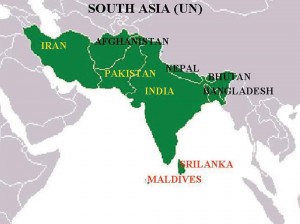 Among the non-traditional security challenges that confront the region are issues of ethnic and religious violence, crises of governance and democracy leading to the Maoist insurgency in Nepal and parts of India, border problems and the issues of illegal migration, poverty, HIV AIDS etc.
Among the non-traditional security challenges that confront the region are issues of ethnic and religious violence, crises of governance and democracy leading to the Maoist insurgency in Nepal and parts of India, border problems and the issues of illegal migration, poverty, HIV AIDS etc.
Geo-Strategic Perceptions
Academics, theorists, and practitioners of geopolitics have agreed upon no standard modern definition for “geo-strategy.” While most definitions emphasise the integration of political goals and military strategy, the original definition has been variously expanded to include non-military aspects —diplomacy, economics, etc.
Pakistan and its border region with Afghanistan along with emerging terror trails in Bangladesh and even Sri Lanka are hot beds of trans-national terrorism.
Historically, there have been two schools of thought on geo-strategy: the Anglo-American school, and the German school. Alfred Thayer Mahan and Halford J. Mackinder outlined the American and British conceptions of geo-strategy, respectively, in their works, “The Problem of Asia” and “Heartland”. Mahan is best known for his “Influence of Sea Power upon History” series of books, which argued that naval supremacy was the deciding factor in great power warfare. In 1900, Mahan’s book, The Problem of Asia laid out the first geo-strategy of the modern era. He divided the continent of Asia into three zones:
- A northern zone, located above the 40th parallel, characterised by its cold climate, and dominated by land power;
- The “Debatable and Debated” zone, located between the 40th and 30th parallels, characterised by a temperate climate; and,
- A southern zone, located below the 30th parallel, characterised by its hot climate, and dominated by sea power.
The “Debated and Debatable” zone, Mahan observed, contained two peninsulas on either end (Asia Minor and Korea), the Isthmus of Suez, the Middle East, two countries marked by mountain ranges (Persia and Afghanistan), the Pamir Mountains, the Tibetan Himalayas, the Yangtze Valley, and Japan. Within this zone, Mahan asserted that there were no strong states capable of withstanding outside influence or capable even of maintaining stability within their own borders. So whereas the political situations to the north and south were relatively stable and determined, the middle remained “debatable and debated ground.” To Mahan, the possession of India by Britain was of key strategic importance, as India was best suited for exerting balancing pressure against Russia in Central Asia. Britain’s predominance in Egypt, China, Australia, and the Cape of Good Hope was also important.
| Editor’s Pick |
Mahan stated that the two most influential lines of division of the world would be the Suez and Panama canals. As most developed nations and resources lay above the North-South division, politics and commerce north of the two canals would be of much greater importance than those occurring south of the canals. As such, the progress of historical development would flow from east to west, in this case leading toward Asia as the locus of advance. Surprisingly, he never mentioned the Malacca Straits in any of his writings. The US were never concerned with this region till the Second World War, and then too marginally. In the late 1980s, Amartya Sen, the Nobel laureate, found every single book on India in the Harvard bookstore was kept in the section called ‘religions’.1
A region is an area with geographical features which can be analysed separately but are inter-dependent e.g. climate, position, structure, land forms, soils, vegetation and the human society dwelling in it. “The words geo-political, strategic, and geo-strategic are used to convey the following meanings: geo-political reflects the combination of geographic and political factors determining the condition of a state or region, and emphasising the impact of geography on politics; strategic refers to the comprehensive and planned application of measures to achieve a central goal or to vital assets of military significance; and geo-strategic merges strategic considerations with geo-political ones.”2
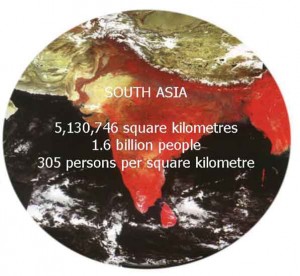 In simple terms, “geo-politics” is the question of who is doing what, to whom, and why in the world. It is an issue which can be ignored at one’s peril. A “geo-strategic region” can be defined as a region within which a state’s interest’s lie and it considers using political, economic and military instruments of power to safeguard its interests. It is important to examine the geo-strategy of South Asia with the focus on the central position of India, given its size and ability to influence the region.
In simple terms, “geo-politics” is the question of who is doing what, to whom, and why in the world. It is an issue which can be ignored at one’s peril. A “geo-strategic region” can be defined as a region within which a state’s interest’s lie and it considers using political, economic and military instruments of power to safeguard its interests. It is important to examine the geo-strategy of South Asia with the focus on the central position of India, given its size and ability to influence the region.
India – The Core of South Asia
“India is a perennial puzzle for geo-politicians. For all its near-billion population, to it’s should-be booming economy and its admirably efficient army, India always seems to be held back by something – it’s fragile sense of national identity, the geographic isolation of the India sub-continent between mountains and sea, may be the inward-looking nature of the Hindu religion – from becoming the sort of country that strides confidently onto the world stage. What India says gets listened to respectfully in the triangle South of the Himalayas; farther afield, it’s voice fades”3
India is on the worlds stage as the first large, economically powerful, culturally vibrant, multi-ethnic, multi-religious democracy outside of the geographic West.
As the modern avatar of an ancient civilisation and heir to the British Empire’s pre-eminence, India’s overriding national security goal is to establish “its rightful place in the emerging world order”4. While the main thrust of Indian foreign policy has been consistent since independence, Indian grand strategy has slowly adjusted since the end of the Cold War. India is now “on the verge of multiple breakthroughs”.5 Even if this assessment proves premature, New Delhi has successfully maintained the general contours of its grand strategy amidst several changes of government since 1991 and is unlikely to make major alterations in the near future.
India is on the world’s stage as the first large, economically powerful, culturally vibrant, multi-ethnic, multi-religious democracy outside of the geographic West. India has the potential to become a leading member of the “political West” and to play a key role politically in the coming decades. Whether it will, and how soon, depends on the readiness of the Western powers to engage India on its own terms.6
In practical terms, securing India’s great power goals imposes two strategic requirements. The first is a sustained economic growth rate.7 Near-term growth depends on uninterrupted access to foreign sources of oil. Given the small contribution that nuclear power currently makes and the long lead time involved in its significant expansion, the oil and natural gas components of energy security occupy a salient position in India’s strategic thinking. India’s geographic position along the sea lines’ connecting the Persian Gulf with Asia’s other growing economies reinforces India’s potential to be a security provider along this crucial route.
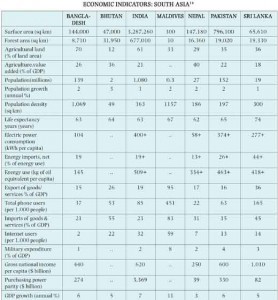 Therefore, the second strategic need is to secure access to energy resources and unhindered foreign trade, which will have an impact on the direction of development. This brings out the importance of the extended South Asia region, which includes the littoral states of the Indian Ocean.
Therefore, the second strategic need is to secure access to energy resources and unhindered foreign trade, which will have an impact on the direction of development. This brings out the importance of the extended South Asia region, which includes the littoral states of the Indian Ocean.
India today belongs to an exclusive club of nations that has deployed nuclear powered submarines, launched remote sensing satellites (with the ability to map the earth’s resources from outer space) and launched intermediate range ballistic missiles. Its launching of the polar satellite launch vehicle in October 1994 was impressive. It is a nuclear power.
South Asia Region as a Power Bloc
South Asia has the maximum languages and dialects in the world. The region is connected by historical and cultural ties in language, faith, belief, customs, traditions and literature and has a common destiny. One cannot prosper without the other and it is only through cooperation within the region that it can compete outside it. It is in the common interest of South Asia that the region develops to become strong, stable and economically prosperous. While its constituents have separate and distinct national identities, they draw from a common consciousness. The region has rich intellectual traditions and a multi-culturalism that reflects respect for diversity and tolerance, and respect of religions. It works to bringing people together rather than talk of a clash of civilisations. “…… nations may clash with one another; cultures and civilisations can co-exist. The 21st century will be shaped by a confluence of civilisations”.8
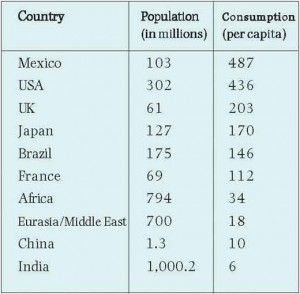 Social and economic ferment is changing South Asia. The awareness and aspirations of the people are increasing. For long the region has been classified as exotic, at best, and disaster-prone or poverty-stricken, at its worst. Developments within the region, in the recent past, are causes of both hope and despair. The events of 9-11 and the London train bombings of July 2006 were set in motion from here. Peace and security in South Asia is indivisible from the threats arising out of international terrorism and the proliferation of weapons of mass destruction, the threat from non-state actors and non-traditional threats such as pandemics, natural and man made disasters, small arms proliferation, narcotics and human trafficking. South Asia is also emerging as an engine of economic development and growth.
Social and economic ferment is changing South Asia. The awareness and aspirations of the people are increasing. For long the region has been classified as exotic, at best, and disaster-prone or poverty-stricken, at its worst. Developments within the region, in the recent past, are causes of both hope and despair. The events of 9-11 and the London train bombings of July 2006 were set in motion from here. Peace and security in South Asia is indivisible from the threats arising out of international terrorism and the proliferation of weapons of mass destruction, the threat from non-state actors and non-traditional threats such as pandemics, natural and man made disasters, small arms proliferation, narcotics and human trafficking. South Asia is also emerging as an engine of economic development and growth.
Parts of the world are focused on modernising, streamlining and privatising their economies. Other parts are caught up in fighting over who owns what. Globalisation is ‘the defining international system’ of the present era. Its central features are the rapid, growing, and uneven cross-border flow of goods, services, people, money, technology, information, ideas, culture, crime, and weapons in an inter-connected world system in which independent networks and flows surmount traditional boundaries (or make them irrelevant). It implies a transformation in the concept of sovereignty. Where does South Asia stand on this stage?
India is seen as a potential market for US products.
In South Asia global economic integration is viewed as a dangerous virus, invading and destroying traditional cultures and values – generating gender and societal confusion, crushing the aspirations of millions of under-skilled workers, and exacerbating inequality, unemployment, insecurity and instability. The focus has, therefore to be on regional cooperation and security, which is tied to economic progress. South Asia needs integrated rail and road systems, regional power and gas grids and the dismantling of artificial impediments to the free flow of goods, services and capital. Restrictions on bilateral trade are forcing import of goods from third countries, which can be traded far more economically and efficiently at prices that can be competitive.
| Editor’s Pick |
Bifurcation of India into Pakistan and India and later Bangladesh, split a single economic entity into three parts that ceased all economic cooperation amongst themselves. Though the best way to avoid war is to make nations inter-dependent, the depths and historical roots of the suspicion and hatred that many national groups have for each other are profound in South Asia. A beginning has been made to secure regional interests through the platform of the South Asian Association for Regional Cooperation (SAARC). It is the largest regional economic and political organisation in the world, established on 8 December 1985 by India, Pakistan, Bangladesh, Sri Lanka, Nepal, Maldives and Bhutan. Its GDP (PPP, 2005) is $4,074,031 million. Its increasing importance is underscored by increase in its membership and countries having observer status at its meetings. However, SAARC trade is less than 5% of overall trade of the region.
India is seen as a potential market for US products. Let us take the example of Coca-Cola, the most ubiquitous brand in history, with 9 million retail outlets all over the world (not considering bars and restaurants), with 1.2 billion servings (8 oz.) consumed daily around the world. Coke has 18% share of the global non-alcoholic ready-to-drink beverage market, with about $ 60 billion as its estimated annual global sales (including its bottling partners. The per capita annual consumption of Coca Cola (8 oz. servings).




